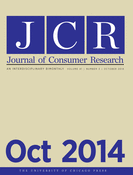-
Views
-
Cite
Cite
Jannine D. Lasaleta, Constantine Sedikides, Kathleen D. Vohs, Nostalgia Weakens the Desire for Money, Journal of Consumer Research, Volume 41, Issue 3, 1 October 2014, Pages 713–729, https://doi.org/10.1086/677227
Close - Share Icon Share
Abstract
Nostalgia has a strong presence in the marketing of goods and services. The current research asked whether its effectiveness is driven by its weakening of the desire for money. Six experiments demonstrated that feeling nostalgic decreased people's desire for money. Using multiple operationalizations of desire for money, nostalgia (vs. neutral) condition participants were willing to pay more for products (experiment 1), parted with more money but not more time (experiment 2), valued money less (experiments 3 and 4), were willing to put less effort into obtaining money (experiment 5), and drew smaller coins (experiment 6). Process evidence indicated that nostalgia's weakening of the desire for money was due to its capacity to foster social connectedness (experiments 5 and 6). Implications for price sensitivity, willingness to pay, consumer spending, and donation behavior are discussed. Nostalgia may be so commonly used in marketing because it encourages consumers to part with their money.



